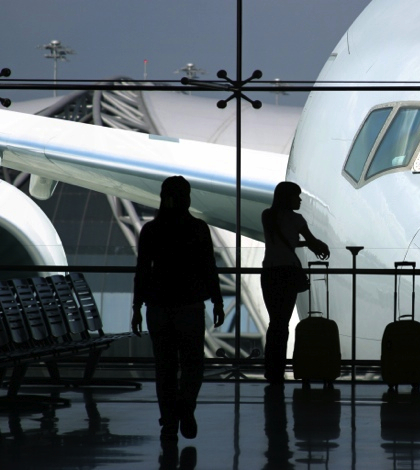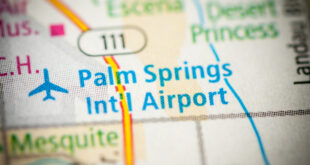Officials in the Inland Empire are anxious to see what the city can do to improve the airport, even though it probably won’t have control of the facility for at least one year. Everyone agrees on one thing: adding more flights and passengers won’t be easy.
After a contentious two-year battle, Los Angeles has agreed to hand over control of Ontario International Airport to Ontario.
That agreement, announced earlier this month, is a historic victory for Ontario, which has seen passenger traffic drop by one-third since 2007, to levels not seen since the mid-1980s.
Now comes the hard part: taking over the airport and making it a profitable operation, which will take time and involve some heavy lifting.
First, Ontario will pay the city of Los Angeles $190 million to gain control of the airport, some of which will involve Ontario assuming $60 million in debt.
Besides transferring control of the airport away Los Angeles, the agreement also gives Ontario all land adjacent to the airport that is owned by Los Angeles World Airports, the agency that owns and operates Ontario International.
Besides its annual payments, Ontario will be obligated to pay Los Angeles $30 million when the land transfer becomes official.
Ontario officials hailed the agreement, saying that the long-term future of the Inland Empire economy depends on making the airport profitable again. The only way that can happen, they argued, is if the airport is managed locally.
“It’s a good deal for Ontario and a good deal for Los Angeles,” Ontario City Councilman Alan Wapner said when the agreement was announced during the airport news conference, which overflowed with elected officials and other dignitaries from both cities. “We also hope it’s the start of more regional cooperation between both cities.”
Wapner is also president of the Ontario International Airport Authority, the agency that will manage the airport once the agreement is made official. Ontario International opened in 1967. LAWA, which also owns and operates Los Angeles International Airport, has operated the airport under a joint powers agreement since 1985.
Until the agreement is official, Ontario has a difficult task on its hands: convincing the public, in the time before the transition becomes official, that the struggling airport is a facility worth using
“What we have to do is convince people to use the airport even though the price of a flight is still expensive,” Wapner said shortly after he and Los Angeles Mayor Eric Garcetti announced the transition agreement.
Even with the Inland economy improving, convincing people to pay more for a flight out of Ontario than they would pay at Los Angeles International Airport – which is also owned and operated by LAWA – will be a tough sell, Wapner conceded.
Ontario will have to increase its marketing, and it will have to convince at least some airlines that operate there to lower their prices.
Officials with Ontario International declined to comment on their marketing plans for the airport.
The city also faces another obstacle, in that it doesn’t know when it will take over the airport. Both city councils must approve the agreement, as well as the airport commissions in Los Angeles and Ontario.
Finally, the Federal Aviation Administration must give its approval, and that could be the biggest obstacle of all. The approval process is expected to take about 12 months, but it could take longer with a federal agency involved.
“More than anything, I would like to see the agreement approved as soon as possible,” said John Husing, Inland economist and a vocal proponent of local control of Ontario International. “The demand for flights [at Ontario International] is there, and we need to take advantage of that.”
With the inland economy improving, John Wayne Airport near capacity and Los Angeles International too far away, now is the time to make Ontario International a major player among Southern California airports.
“If you live on this side of the 605 Freeway, you would be crazy to fly out of Los Angeles if you could get a similar flight out of Ontario at the same price,” said Husing, who is predicting that Riverside and San Bernardino counties will add roughly 60,000 jobs next year. “That’s what they need to market.
“But what they really need to do is get this [agreement] approved quickly.”
Because the success of the airport is so important to the local economy, all of the Inland Empire business community is anxious to see the airport ownership transferred as soon as possible, said Sue Oxarart, communications director for the Greater Ontario Convention & Visitors Bureau.
“We hope to see some expanded flights, even if it means having to cut some fees, to get them,” Oxarart said. “Ultimately, the goal should be to get passenger levels back to where they were in 2007, before the recession hit. The question is, how do we get there? That’s what we’re waiting to see.”
One financial institution is also anxious to see how the new ownership arrangement works out.
Five days after the agreement was announced, Fitch Ratings Inc. issued a statement on the airport agreement between Los Angeles and Ontario that said the agreement “is likely to provide for a more politically acceptable and stable ownership framework” for the airport.
The credit rating agency then listed several potential trouble spots related to handing control of the airport over to Ontario, starting with the uncertainty regarding when the transfer of ownership will become official.
“Questions remain on the ability to carry through with a successful transition of ownership, management and operations,” Fitch Ratings wrote in a statement. “There are not many examples to point to … where an airport changed ownership control from one public entity to another.”
The change in ownership is not likely to create any major changes in Ontario International’s traffic count, which has risen steadily during the past year due in part to a boost in international travel.
Also, given its location and the degree of competition it faces, adding more airline services will be a “constant challenge,” Fitch Ratings predicted.
 IE Business Daily Business news for the Inland Empire.
IE Business Daily Business news for the Inland Empire.


